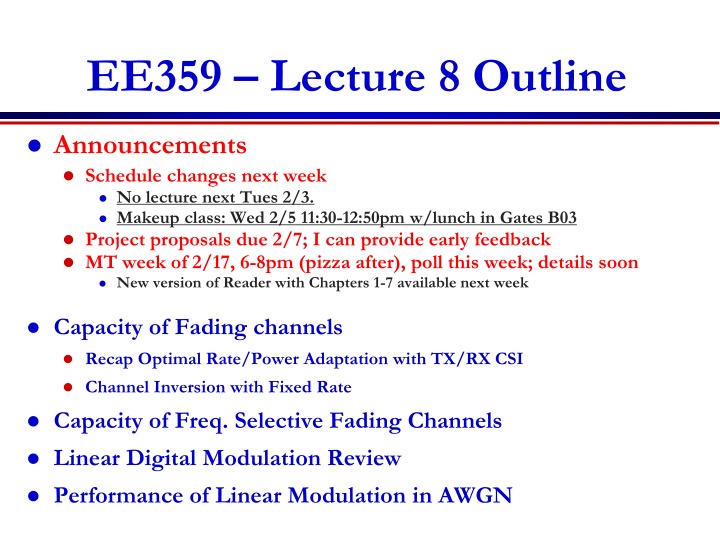
Advanced Concepts in Communication Channels: Capacity, Fading, and Modulation
Explore the intricate details of channel capacity, fading phenomena, and digital modulation in communication systems. Discover the implications of fading statistics, adaptive strategies, and capacity optimization in various channel scenarios.
Download Presentation

Please find below an Image/Link to download the presentation.
The content on the website is provided AS IS for your information and personal use only. It may not be sold, licensed, or shared on other websites without obtaining consent from the author. If you encounter any issues during the download, it is possible that the publisher has removed the file from their server.
You are allowed to download the files provided on this website for personal or commercial use, subject to the condition that they are used lawfully. All files are the property of their respective owners.
The content on the website is provided AS IS for your information and personal use only. It may not be sold, licensed, or shared on other websites without obtaining consent from the author.
E N D
Presentation Transcript
EE359 Lecture 8 Outline Announcements Schedule changes next week No lecture next Tues 2/3. Makeup class: Wed 2/5 11:30-12:50pm w/lunch in Gates B03 Project proposals due 2/7; I can provide early feedback MT week of 2/17, 6-8pm (pizza after), poll this week; details soon New version of Reader with Chapters 1-7 available next week Capacity of Fading channels Recap Optimal Rate/Power Adaptation with TX/RX CSI Channel Inversion with Fixed Rate Capacity of Freq. Selective Fading Channels Linear Digital Modulation Review Performance of Linear Modulation in AWGN
Review of Last Lecture Channel Capacity Maximum data rate that can be transmitted over a channel with arbitrarily small error Capacity of AWGN Channel: Blog2[1+ ] bps =Pr/(N0B) is the receiver SNR Capacity of Flat-Fading Channels Nothing known: capacity typically zero Fading Statistics Known (few results) Fading Known at RX (average capacity) ( ) ) ( 1 log 0 = + + log 1 ( 2 ) C B p d B 2
Review of Last Lecture (ctd) Capacity in Flat-Fading: known at TX/RX max Same result with equality ( + ) P = ( log 1 ) C B p d 2 ( ( : ) [ )] P E P P P 0 Optimal Rate and Power Adaptation Waterfilling 0 ( P ) P 1 1 1 = 0 0 0 else 1 C = log ( ) . p d 2 B 0 0 0 The instantaneous power/rate only depend on p( ) through 0
Channel Inversion Fading inverted to maintain constant SNR Simplifies design (fixed rate) Greatly reduces capacity Capacity is zero in Rayleigh fading Truncated inversion Invert channel above cutoff fade depth Constant SNR (fixed rate) above cutoff Cutoff greatly increases capacity Close to optimal
Capacity in Flat-Fading Rayleigh AWGN Log-Normal AWGN TX/RX CSI Truncated Inversion RX CSI Inversion TX/RX CSI Truncated Inversion AWGN capacity lower than w/fading under TX/RX CSI Inversion RX CSI
Frequency Selective Fading Channels For time-invariant channels, capacity achieved by water-filling in frequency Capacity of time-varying channel unknown Approximate by dividing into subbands Each subband has width Bc (like MCM/OFDM). Independent fading in each subband Capacity is the sum of subband capacities 1/|H(f)|2 Total Power 1/ 0 P(fi) Bc f 1/|H(fi)|2 fi
Review of Linear Digital Modulation Signal over ith symbol period: = t g s t s i + + ( ) ( ) cos( 2 ) ( ) sin( 2 ) f t s g t f t 1 0 2 0 c i c Pulse shape g(t) typically Nyquist Signal constellation defined by (si1,si2) pairs Can be differentially encoded M values for (si1,si2) log2 M bits per symbol Ps depends on Minimum distance dmin (depends on s) # of nearest neighbors M Approximate expression: Standard/alternate Q function ( ) P Q s M M s
Main Points Channel inversion practical, but should truncate or get a large capacity loss Capacity of wideband channel obtained by breaking up channel into subbands Similar to multicarrier modulation Linear modulation dominant in high-rate wireless systems due to its spectral efficiency ( ) P Q Ps approximation in AWGN: Alternate Q function useful in diversity analysis s M M s
